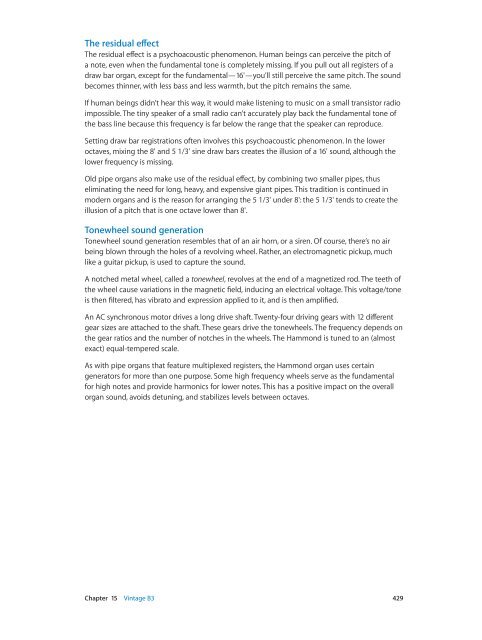Apple MainStage 3 Instruments - MainStage 3 Instruments
Apple MainStage 3 Instruments - MainStage 3 Instruments
Apple MainStage 3 Instruments - MainStage 3 Instruments
You also want an ePaper? Increase the reach of your titles
YUMPU automatically turns print PDFs into web optimized ePapers that Google loves.
The residual effect<br />
The residual effect is a psychoacoustic phenomenon. Human beings can perceive the pitch of<br />
a note, even when the fundamental tone is completely missing. If you pull out all registers of a<br />
draw bar organ, except for the fundamental—16'—you’ll still perceive the same pitch. The sound<br />
becomes thinner, with less bass and less warmth, but the pitch remains the same.<br />
If human beings didn’t hear this way, it would make listening to music on a small transistor radio<br />
impossible. The tiny speaker of a small radio can’t accurately play back the fundamental tone of<br />
the bass line because this frequency is far below the range that the speaker can reproduce.<br />
Setting draw bar registrations often involves this psychoacoustic phenomenon. In the lower<br />
octaves, mixing the 8' and 5 1/3' sine draw bars creates the illusion of a 16' sound, although the<br />
lower frequency is missing.<br />
Old pipe organs also make use of the residual effect, by combining two smaller pipes, thus<br />
eliminating the need for long, heavy, and expensive giant pipes. This tradition is continued in<br />
modern organs and is the reason for arranging the 5 1/3' under 8': the 5 1/3' tends to create the<br />
illusion of a pitch that is one octave lower than 8'.<br />
Tonewheel sound generation<br />
Tonewheel sound generation resembles that of an air horn, or a siren. Of course, there’s no air<br />
being blown through the holes of a revolving wheel. Rather, an electromagnetic pickup, much<br />
like a guitar pickup, is used to capture the sound.<br />
A notched metal wheel, called a tonewheel, revolves at the end of a magnetized rod. The teeth of<br />
the wheel cause variations in the magnetic field, inducing an electrical voltage. This voltage/tone<br />
is then filtered, has vibrato and expression applied to it, and is then amplified.<br />
An AC synchronous motor drives a long drive shaft. Twenty-four driving gears with 12 different<br />
gear sizes are attached to the shaft. These gears drive the tonewheels. The frequency depends on<br />
the gear ratios and the number of notches in the wheels. The Hammond is tuned to an (almost<br />
exact) equal-tempered scale.<br />
As with pipe organs that feature multiplexed registers, the Hammond organ uses certain<br />
generators for more than one purpose. Some high frequency wheels serve as the fundamental<br />
for high notes and provide harmonics for lower notes. This has a positive impact on the overall<br />
organ sound, avoids detuning, and stabilizes levels between octaves.<br />
Chapter 15 Vintage B3 429
















